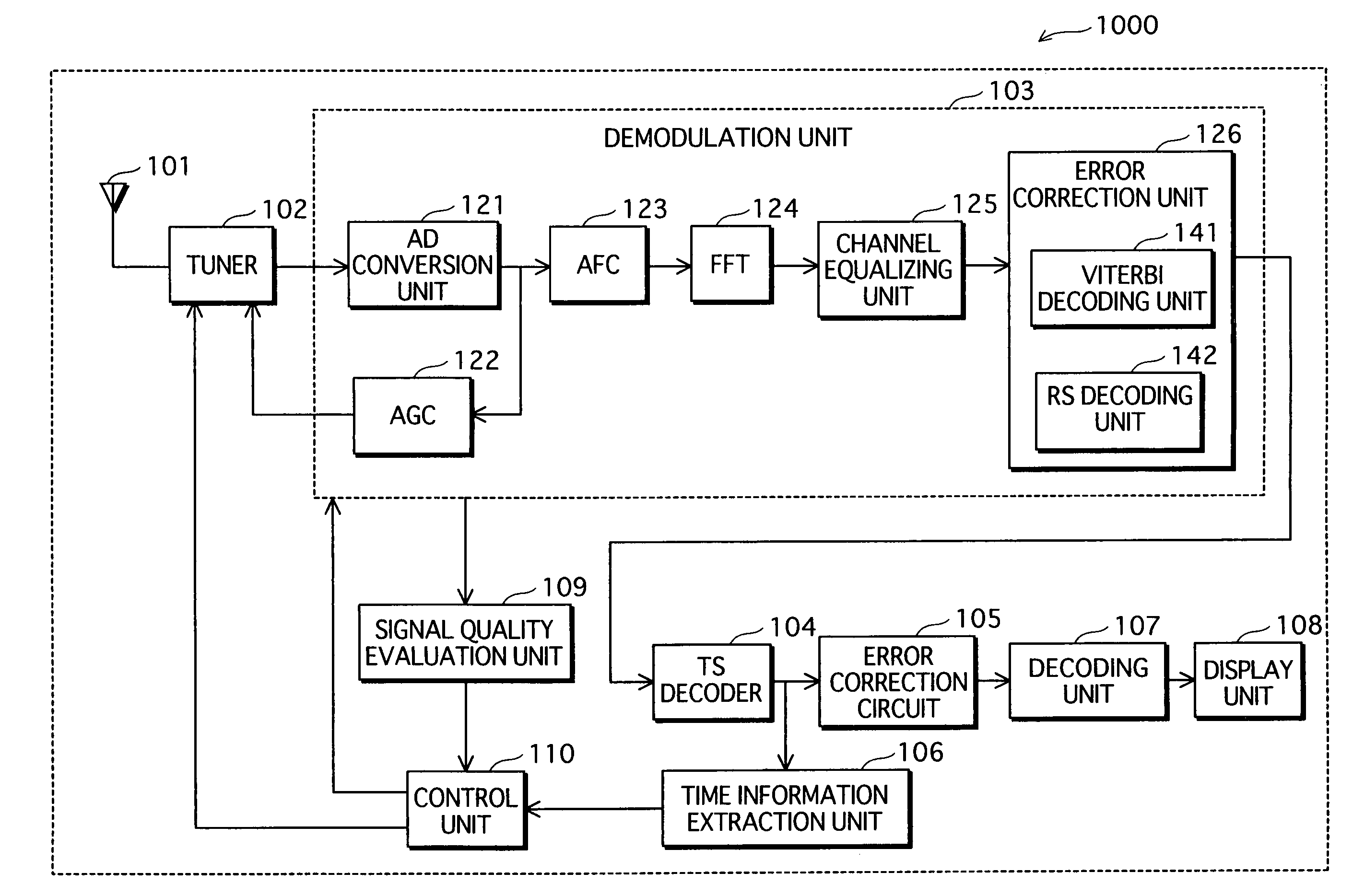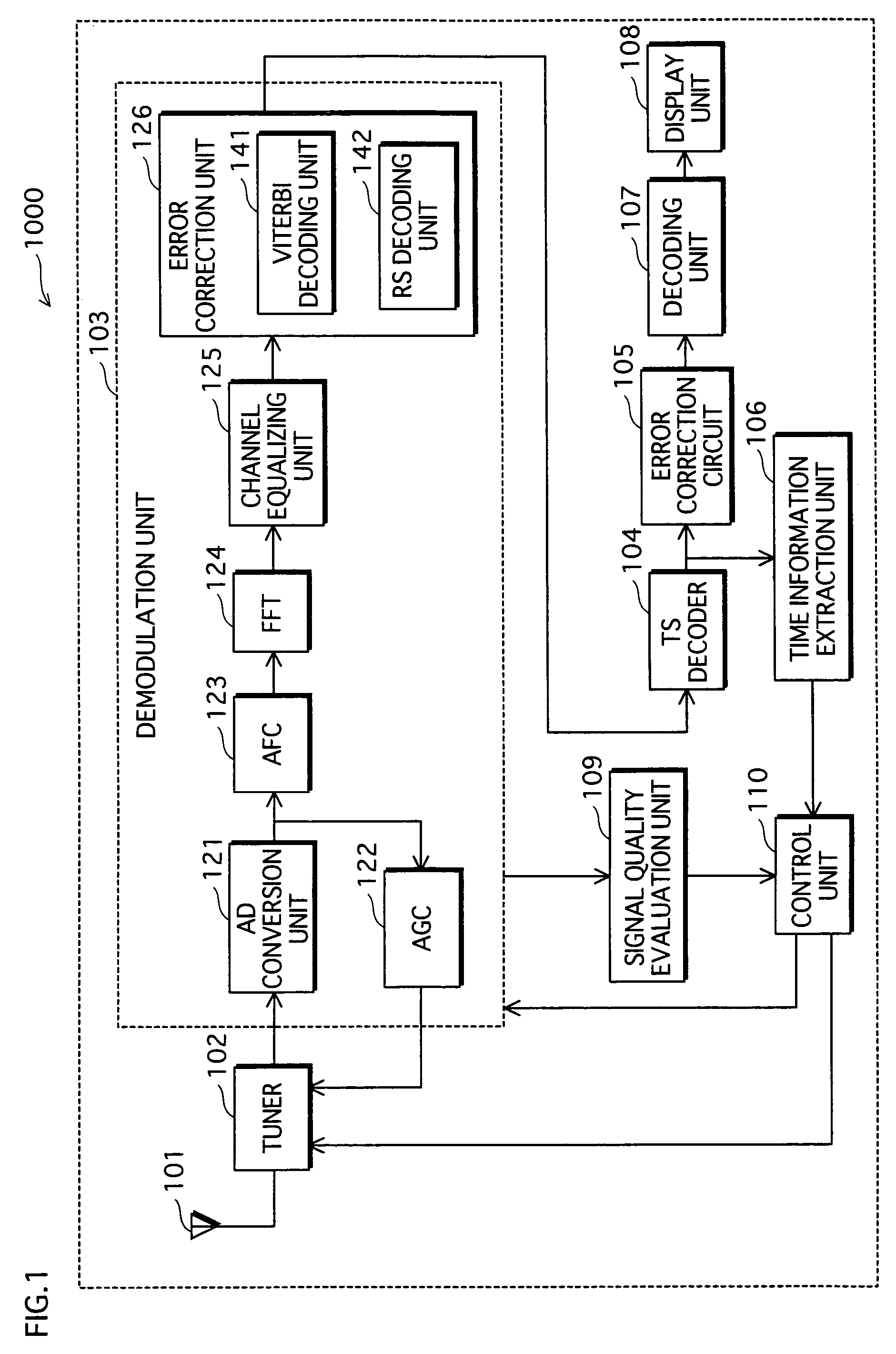Time division multiplexed signal receiver apparatus
a receiver apparatus and time division multiplex technology, applied in the field of time division multiplexed signal receiver apparatus, can solve the problems of frequency fluctuations and adversely affect the reception of signals, and achieve the effects of reducing the number of times of operation
- Summary
- Abstract
- Description
- Claims
- Application Information
AI Technical Summary
Benefits of technology
Problems solved by technology
Method used
Image
Examples
first embodiment
[0025]FIG. 1 is a functional block diagram showing a receiver apparatus according to a first embodiment.
[0026]A receiver apparatus 1000 shown in the drawing receives a time-division multiplexed signal according to, for example, DVB-H (Digital Video Broadcasting-Handheld). DVB-H is a transmission method that adapts data broadcasting of DVB-T (Digital Video Broadcasting-Terrestrial) which is a terrestrial digital television transmission method in Europe, for bringing broadcast services to mobile receivers.
[0027]As shown in the drawing, the receiver apparatus 1000 includes an antenna 101, a tuner 102, a demodulation unit 103, a TS (Transport Stream) decoder 104, an error correction circuit 105, a time information extraction unit 106, a decoding unit 107, a display unit 108, a signal quality evaluation unit 109, and a control unit 110. The demodulation unit 103 is composed of a plurality of circuits.
[0028]The antenna 101 receives a DVB-H broadcast signal which is transmitted by time-div...
second embodiment
[0073]The following describes a receiver apparatus according to a second embodiment.
[0074]In the second embodiment, pull-in time ΔTcap is determined based on a previous pull-in time, when determining the operation start time. The following explanation mainly focuses on the difference from the first embodiment.
[0075]FIG. 6 is a functional block diagram showing the receiver apparatus of the second embodiment.
[0076]A receiver apparatus 1100 shown in the drawing differs from the receiver apparatus 1000 of the first embodiment, in that a pull-in time measuring unit 111 is provided in place of the signal quality evaluation unit 109. Construction elements such as the antenna 101 are the same as those of the first embodiment, and so their explanation has been omitted here.
[0077]The pull-in time measuring unit 111 has a timer function of counting a time, and may be constituted by a CPU, a ROM, a RAM, and the like. The pull-in time measuring unit 111 measures pull-in time ΔTcap, and stores on...
third embodiment
[0087]The following describes a receiver apparatus according to a third embodiment.
[0088]In the third embodiment, pull-in time ΔTcap is determined based on a remaining battery level of the receiver apparatus in addition to the quality of the received signal, when determining the operation start time. The following explanation mainly focuses on the difference from the first embodiment.
[0089]FIG. 8 is a functional block diagram showing the receiver apparatus of the third embodiment.
[0090]A receiver apparatus 1200 shown in the drawing includes a battery monitoring unit 112 in addition to the construction of the receiver apparatus 1000 of the first embodiment.
[0091]The battery monitoring unit 112 measures the remaining battery level of the receiver apparatus 1200, and outputs the measured remaining battery level to the control unit 110 in percentage as one example.
[0092]The control unit 110 controls the timing to supply power to the tuner 102 and the like based on the quality of the rec...
PUM
 Login to View More
Login to View More Abstract
Description
Claims
Application Information
 Login to View More
Login to View More - R&D
- Intellectual Property
- Life Sciences
- Materials
- Tech Scout
- Unparalleled Data Quality
- Higher Quality Content
- 60% Fewer Hallucinations
Browse by: Latest US Patents, China's latest patents, Technical Efficacy Thesaurus, Application Domain, Technology Topic, Popular Technical Reports.
© 2025 PatSnap. All rights reserved.Legal|Privacy policy|Modern Slavery Act Transparency Statement|Sitemap|About US| Contact US: help@patsnap.com



